How To Have A Filter Ignore Another Filter Tableau
Filtering is an essential role of analyzing data. This article describes the many ways you can filter data from your view. It also describes how you tin can display interactive filters in the view, and format filters in the view.
Watch a Video: To see related concepts demonstrated in Tableau, watch these free training videos: Ways to Filter(Link opens in a new window) (2 minutes), Where Tableau Filters(Link opens in a new window) (4 minutes), Using the Filter Shelf(Link opens in a new window) (7 minutes), Interactive Filters(Link opens in a new window) (4 minutes), and Additional filtering topics(Link opens in a new window) (vii minutes). Use your tableau.com(Link opens in a new window) account to sign in.
Filtering Order of Operations
Before you begin filtering data in Tableau, it's important to empathise the order in which Tableau executes filters in your workbook.
Tableau performs actions on your view in a very specific order; this is called the Order of Operations. Filters are executed in the following order:
-
Extract filters
-
Information source filters
-
Context filters
-
Filters on dimensions (whether on the Filters shelf or in filter cards in the view)
-
Filters on measures (whether on the Filters shelf or in filter cards in the view)
To acquire more, see Tableau'south Order of Operations(Link opens in a new window).
Notation: When yous drag a discrete dimension to the Filters shelf, the Filter dialog box offers 4 tabs for filtering: Full general, Wildcard, Status, and Top. The settings on each of these tabs are condiment starting with the General tab; what y'all assault each tab will bear on the filter results on each tab to the right. For details on the Filter dialog box, see Drag dimensions, measures, and appointment fields to the Filters shelf and Filter categorical data (dimensions).
Select to go on or exclude data points in your view
You tin filter individual data points (marks), or a pick of data points from your view. For example, if yous have a scatter plot with outliers, you tin exclude them from the view then you can better focus on the rest of the data.
To filter marks from the view, select a unmarried marking (data bespeak) or click and drag in the view to select several marks. On the tooltip that appears, you can:
-
Select Keep But to go along only the selected marks in the view.
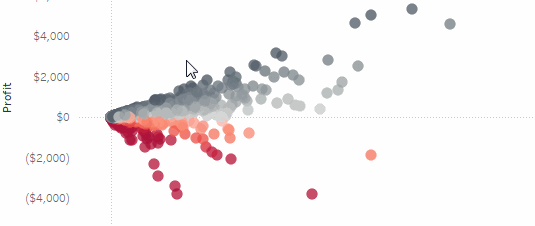
-
Select Exclude to remove the selected marks from the view.

Note: These filtering options are non available if a Wildcard Friction match filter is already specified for the aforementioned field. Run across Drag dimensions, measures, and date fields to the Filters shelf (Link opens in a new window) to learn more nigh Wildcard Match filters.
You tin also select headers to filter them from your view.
To filter entire rows or columns of data from your view, select the header in the view. On the tooltip that appears, select to Exclude or Keep But the selected information.
When you select a table header that is part of a hierarchy, all of the next level headers are too selected. For example, the view shown beneath consists of two unrelated dimensions placed on the Columns shelf, and two levels of the same bureaucracy placed on the Rows shelf.
The selected row headers include the Furniture member of the Category dimension, and the Binders and Labels members of the Sub-category dimension. When Article of furniture is selected, all members from the side by side (inner) level in the hierarchy are automatically selected. In this example, that means the Bookcases, Chairs, Furnishings, and Tables members.

Drag dimensions, measures, and date fields to the Filters shelf
Some other way to create a filter is to drag a field directly from the Data pane to the Filters shelf.

When y'all add a field to the Filters shelf, the Filter dialog box opens so you can define the filter. The Filter dialog box differs depending on whether you are filtering categorical data (dimensions), quantitative data (measures), or date fields.
Filter categorical data (dimensions)
Dimensions contain detached categorical data, and so filtering this type of field more often than not involves selecting the values to include or exclude.
When you drag a dimension from the Information pane to the Filters shelf in Tableau Desktop, the following Filter dialog box appears:

-
Full general: Utilize the General tab to select the values yous want to include or exclude.
-
Wildcard (Tableau Desktop only): Utilise the Wildcard tab to ascertain a pattern to filter on. For case, when filtering on email addresses you lot might desire to simply include emails from a specific domain. Yous can define a wildcard filter that ends with "@gmail.com" to only include Google email addresses.
-
Condition: Use the Status tab in the Filter dialog box to define rules to filter by. For example, in a view showing the boilerplate Unit of measurement Toll for a collection of products, you may want to only prove the Products that have an average unit of measurement cost that is greater than or equal to $25. Yous can employ the built-in controls to write a condition or yous can write a custom formula.
-
Top: Use the Height tab in the Filter dialog box to define a formula that computes the data that will be included in the view. For instance, in a view that shows the boilerplate Time to Ship for a drove of products, you can decide to only bear witness the top 15 (or bottom) products by Sales. Rather than having to define a specific range for Sales (eastward.g., greater than $100,000), yous can define a limit (acme 15) that is relative to the other members in the field (products).
Of import Note: Each tab adds additional definitions to your filter. For example, you can select to exclude values under the Full general tab, and likewise add together limits nether the Top tab. Selections and configurations from both tabs are applied to your filter.
At any time, you tin run across the definitions of your filter nether Summary on the General tab.
Filter quantitative data (measures)
Measures contain quantitative data, so filtering this type of field generally involves selecting a range of values that you lot desire to include.
When you drag a measure from the Data pane to the Filters shelf in Tableau Desktop, the following dialog box appears:

Select how you want to aggregate the field, and so click Side by side.
In the subsequent dialog box, you're given the choice to create four types of quantitative filters:
Range of Values: Select the Range of Values option to specify the minimum and maximum values of the range to include in the view. The values you specify are included in the range.
At Least: Select the At Least option to include all values that are greater than or equal to a specified minimum value. This type of filter is useful when the data changes oft so specifying an upper limit may not be possible.
At Nigh: Select the At Most option to include all values that are less than or equal to a specified maximum value. This type of filter is useful when the information changes often so specifying a lower limit may not be possible.
Special: Select the Special option to filter on Null values. Include only Goose egg values, Non-nil values, or All Values.
Note: If you lot have a large information source, filtering measures can lead to a significant degradation in performance. Information technology is sometimes much more efficient to filter by creating a set up containing the measure and then apply a filter to the set. For more information about creating sets, see Create Sets(Link opens in a new window).
Filter dates
When you drag a date field from the Information pane to the Filters shelf in Tableau Desktop, the following Filter Field dialog box appears:
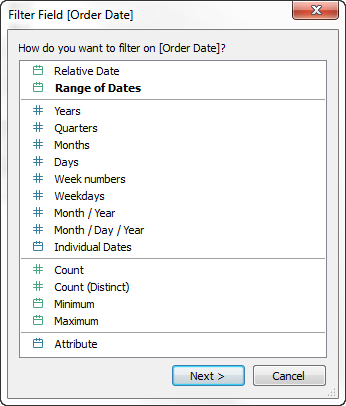
You can select whether you want to filter on a relative appointment; filter between a range of dates; or select detached dates or individual dates to filter from the view.
-
Filter relative dates: Click Relative dates to define a range of dates that updates based on the appointment and fourth dimension yous open the view. For instance, y'all may want to come across Yr to Date sales, all records from the past 30 days, or bugs closed last week. Relative date filters can also be relative to a specific anchor date rather than today.
-
Filter a range of dates: Select Range of dates to define a fixed range of dates to filter. For example, you may want to see all orders placed between March 1, 2009 and June 12, 2009.
-
Filter discrete dates: Select a detached date value in the dialog box if you want to include entire date levels. For example, if you select Quarters, you can cull to filter specific quarters (eastward.k. Q1, Q2, Q3, Q4) from your view, regardless of the year.
Latest date preset: If you want to ensure that only the most recent appointment in a data source is selected in the filter when the workbook is shared or opened, select a detached date such as Calendar month/Day/Year or Individual Dates and then, on the General tab, select Filter to latest appointment value when workbook is opened.


Notes: When you filter to the latest date value, this setting applies only to data source filters in a workbook.
In the order of operations, the latest date filter is global to the workbook, while context filters apply per worksheet. The latest appointment is determined just later the workbook opens for offset use, after data source filters, but before context filters. At that point the date is set, and the latest date preset is used as a dimension filter.
If yous are using boosted filters in views (including relative date filters and context filters), the latest date value setting may consequence in an empty view with no data when those boosted filters practice not select data from the latest date in the database.
On Tableau Server and Tableau Online, presets are practical when the view beginning loads in the browser, only not when the browser or information is refreshed.
-
Filter private dates: Select Individual dates to filter specific dates from your view.
-
Boosted appointment filter options: When you select Relative dates or Range of dates, the Filter dialog box opens. In that dialog box, yous can define a Starting appointment or Ending appointment. You lot can likewise select Special to include zilch dates, non-goose egg dates, or all dates.
Filter table calculations
To create a table adding filter, create a calculated field, and then place that field on the Filters shelf.
Filters based on tabular array calculations do not filter out underlying information in the data gear up, because table adding filters are applied last in the order of operations. This means Tableau evaluates whatever table calculations in the view get-go, and then applies tabular array calculation filters on the results in the current view.
Utilise tabular array calculation filter to totals
When you lot evidence totals in a view and you want a table adding filter to utilise to the totals, you can select Apply to totals in the drop-down menu for that filter (on the Filters shelf). This option lets you make up one's mind when a tabular array calculation filter should be applied to totals.
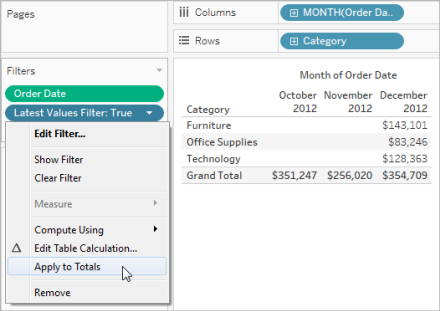
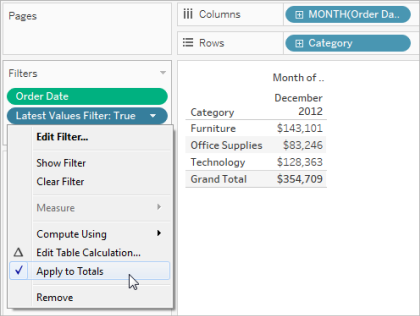
This options is available when you show totals in the view, and you add a table adding filter to the view. Select Employ to totals to apply the tabular array calculation filter to all of the results in the tabular array, including the totals.
Display interactive filters in the view
When an interactive filter is shown, you can quickly include or exclude data in the view.
Notation: In spider web authoring, interactive filters are automatically added to the view when you lot elevate a field to the Filters shelf.
To evidence a filter in the view:
- In the view, click the field driblet-down card and select Prove Filter.

The field is automatically added to the Filters shelf (if information technology is not already existence filtered), and a filter card appears in the view. Interact with the carte du jour to filter your data.
Note: In Tableau Desktop, you tin can add together an interactive filter to the view for a field that is non currently used in the view. To exercise so, In the Information pane, click the field driblet-down menu, and then select Show Filter.
Set options for filter carte du jour interaction and advent
After you show a filter, at that place are many unlike options that let you control how the filter works and appears. You tin access these options by clicking the drop-downwardly menu in the upper right corner of the filter carte du jour in the view.

Some options are available for all types of filters, and others depend on whether you're filtering a categorical field (dimension) or a quantitative field (mensurate).
Y'all can customize how filters appear in the view, in dashboards, or when published to Tableau Server or Tableau Online.
Here are some of the general filter card options:
-
Edit Filter - This option opens the master Filter dialog box so you tin further refine the filter by adding weather condition and limits.
-
Remove Filter - Removes the filter from the Filters shelf and removes the filter carte du jour from the view.
-
Apply to worksheets - Allows you to specify whether the filter should utilize to but the current worksheet or be shared beyond multiple worksheets. For more data, run across Utilize Filters to Multiple Worksheets.
-
Format Filters (Tableau Desktop merely) - Customize the font and colors of all your filter cards in the view.
-
Simply relevant values - Specifies which values to show in the filter. When you select this option other filters are considered and only values that pass these filters are shown. For example, a filter on Land will merely show the Eastern states when a filter on Region is set. Y'all can use the toggle at the top of the filter card to switch between this choice and the All Values in Database option.
-
All values in bureaucracy - Specifies which values to prove in the filter. When you create a filter from a hierarchical field, this option is selected past default. Filter values are displayed based on relevance of the parent/kid relationships in the hierarchy.
-
All values in database - Specifies which values to show in the filter. When yous select this choice all values in the database are shown regardless of the other filters on the view.
-
All values in context (Tableau Desktop only) - When one of the filters in the view is a context filter, select this pick on a different filter to only display values that pass through the context filter. For more information, run across Use Context Filters.
-
Include values - When this option is selected, the selections in the filter card are included in the view.
-
Exclude values - When this option is selected, the selections in the filter card are excluded from the view.
-
Hide Card (Tableau Desktop only) - Hides the filter card only does non remove the filter from the Filters shelf.
Filter carte modes
You can command the appearance and interaction of your filter menu in the view past selecting a filter card mode.
To select a filter card way, in the view, click the drop-downwards menu on the filter card and then select a mode from the listing.

The types of filter card modes you lot run into in the list of options depend on whether your filter is on a dimension or a measure. Below yous tin can discover brief descriptions of the types of filter bill of fare modes available for dimensions and measures.
For dimensions, you lot can choose from the following filter modes:
-
Unmarried Value (List): Displays the values of the filter equally a list of radio buttons where simply a single value can exist selected at a time.
-
Single Value (Dropdown): Displays the values of the filter in a drop-down list where just a single value can be selected at a time.
-
Single Value (Slider): Displays the values of the filter forth the range of a slider. Just a unmarried value tin be selected at a fourth dimension. This pick is useful for dimensions that have an implicit gild such as dates.
-
Multiple Values (List):Displays the values in the filter as a list of check boxes where multiple values can be selected.
-
Multiple Values(Dropdown): Displays the values of the filter in a drop-downwards list where multiple values can be selected.
-
Multiple Values (Custom List): Displays a text box where you tin type a few characters and search for the value. Alternatively, you tin type or paste a list of values into the text box to create a custom list of values to include.
-
Wildcard Match: Displays a text box where you tin can type a few characters. All values that match those characters are automatically selected. You can employ the asterisk grapheme equally a wildcard character. For case, y'all can type "tab*" to select all values that brainstorm with the letters "tab". Pattern Match is not case sensitive. If you lot are using a multidimensional data source, this option is just available when filtering single level hierarchies and attributes.
For measures, you tin can cull from the following filter modes:
-
Range of Values/Dates: shows the filtered values equally a pair of sliders that you can suit to include or exclude more values. Click on the upper and lower limit readouts to enter the values manually.
The darker area inside the slider range is called the data bar. It indicates the range in which information points really lie in the view. Use this indicator to determine a filter that makes sense for the data in your information source. For case, you may filter the Sales field to only include values between $200,000 and $500,000 but your view only contains values between $250,000 and $320,000. The range of data you tin can see in the view is indicated by the data bar while the sliders show y'all the range of the filter.
-
Notation: Information bars simply show in filters where the filtered field is besides used in the view (eastward.g., on Columns, Rows, or on the Marks card, and son on) and are at the aforementioned assemblage level as the field on the Filters shelf. For instance, a filter on SUM(Sales) will only display data bars if the SUM(Sales) field is used in the view. It won't show if AVG(Sales) is used in the view. Even though in both scenarios, the filtered field, Sales is used in the view; in the latter case the aggregation is different than the aggregation of the filter.
-
At Least/Starting Date: shows a single slider with a fixed minimum value. Use this option to create a filter using an open ended range.
-
At Most/Ending Date: shows a slider with a fixed maximum value. Use this option to create a filter using an open up ended range.
-
Relative to Now: this option shows a control where y'all can define a dynamic appointment range that updates based on when y'all open the view. The option is merely available for filters on continuous engagement fields.
-
Browse periods: shows common date ranges such as past day, calendar week, month, 3 months, one year, and five years. This option is only available for filters on continuous engagement fields.
Note: When you expose a filter for Measure out Values or Measure Names equally a single value list, selecting All will automatically convert the filter to a multiple values list. For information on Measure out Values and Mensurate Names, come across Mensurate Values and Measure out Names.
Customize filter cards
In addition to the general filter options and the filter modes, you control how your filter appears in the worksheet, on dashboards, or when published to the spider web fifty-fifty further in Tableau Desktop.
To customize filters, click the filter card drop-down menu and select Customize.
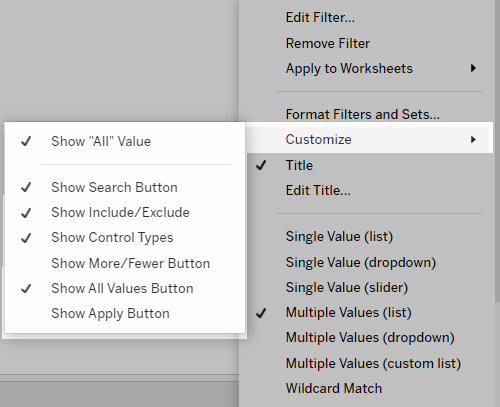
Yous can select from the following options:
-
Evidence "All" Value - toggles whether to show the "All" pick that displays by default in multiple values and unmarried value lists.
-
Show Search Button - toggles whether to show the search push button at the top of the filter.
-
Bear witness Include/Exclude - toggles whether to show the Include Values and Exclude Values commands on the filter card bill of fare. When shown, users can switch the filter between include and exclude modes.
-
Show Command Types - toggles whether to let users change the type of quick filter shown. For case, when shown, a user can change a multiple values listing to a compact list.
-
Show More/Fewer push button - toggles whether to show the More/Fewer button
 at the meridian of the filter.
at the meridian of the filter. -
Evidence All Values button - toggles whether to display the Show All Values button
 on the filter card.
on the filter card. Whenever data is excluded in the filter, the small red "ten" appears on the Evidence All Values button. When all values are showing, the reddish "x" disappears.
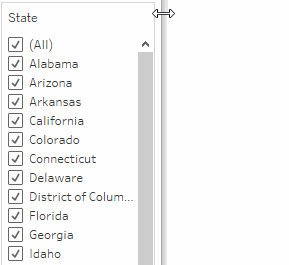
-
Bear witness Apply Push - toggles whether to show the Use push button at the bottom of the filter. When shown, changes to the filter are simply applied after y'all click the button. Awaiting changes are indicated with a green color. This selection is merely bachelor in multiple values lists and dropdowns. This options is bachelor in spider web authoring.
-
Show Readouts - controls whether the minimum and maximum values are displayed as text above a range of values. The readouts tin be used to manually type a new value instead of using the sliders.
-
Show Slider - controls whether the slider displays. When this option is cleared, the filter only displays the readouts.
-
Show Null Controls - shows a drib-down listing that lets you control how the filter handles null values. You can select from values in a range; values in a range and null values; cipher values only, non-cipher values, or all values.
-
Note: Not all of the in a higher place options are available for views published to Tableau Server or Tableau Online.
See Besides
-
Filter Data from Data Sources(Link opens in a new window)
-
Restrict Access at the Data Row Level(Link opens in a new window)
Other articles in this department
How To Have A Filter Ignore Another Filter Tableau,
Source: https://help.tableau.com/current/pro/desktop/en-us/filtering.htm
Posted by: crismanlair1941.blogspot.com


0 Response to "How To Have A Filter Ignore Another Filter Tableau"
Post a Comment